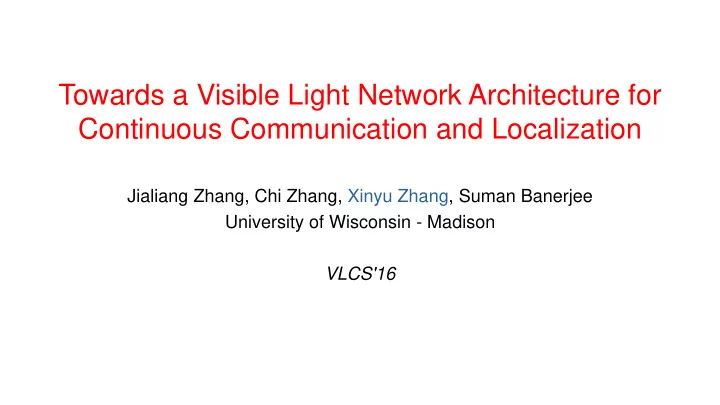

Towards a Visible Light Network Architecture for Continuous Communication and Localization Jialiang Zhang, Chi Zhang, Xinyu Zhang, Suman Banerjee University of Wisconsin - Madison VLCS'16
Landmarks of VL Communication Technology • 2000 – Early research in VLC – 802.11 standard for infrared communication • 2011 – 802.15.7 standard for VLC, 96 Mbps • State-of-the-art – Gbps, single-link, short range – Centimeter-precision localization
Challenges for reliable, ubiquitous VLC • Prior work mainly focused on – Point-to-point communication – Static scenario • Challenges towards ubiquitous VLC – Lack of multipath diversity reduces reliability – Human blockage/shadowing often reduces link rate to 0
Challenges for reliable, ubiquitous VLC • Poor reliability also compromises VL localization – Prior VL localization only focused on small scale localization – Blockage/shadowing/movement causes service interrution
Challenges for reliable, ubiquitous VLC • A usable communication/localization scheme should be transparent to users – Ubiquitous, seamless connectivity – Always available without user intervention • VLC is not such a technology yet! – PHY communication cannot solve the issue – Need new network architecture!
From VLC to VLN From VLC
From VLC to VLN From VLC Architecture for connectivity management
From VLC to VLN From VLC To VLN Architecture for connectivity management
Goals • Continuous communication – Seamless roaming – Uninterrupted service • Realtime localization – More landmarks, better accuracy
Components of VLN • Front-haul – Clusters of APs like “distributed antennas” – Tight PHY cooperation • Back-haul – Connecting APs to central server • Central server – Centralized MAC to maximize throughput and minimize outage
Front-haul • Downlink AP with smart LED – Sync and cooperate at symbol-level – Balancing diversity and spatial reuse • Uplink via Wi-Fi – A critical feedback channel with high reliability – Reusing current infrastructure simplifies deployment
Back-haul • Power Line Communication (PLC) – Dual role front-haul: lighting and communication – Back-haul uses PLC adapters to facilitate these 2 roles – No need for new wiring
Central server • Connectivity management – Coordinates APs – Collects channel feedback from clients • Realtime localization – Spatial relations of APs are known to server – Reliably localizes a client based on feedback – Facilitates active connectivity management
Connectivity Management • Dynamic clustering – Increases SNR, expands range • Soft binding – All APs form a single virtual AP – No reassociation needed for roaming • Centralized MAC – Frame based scheduling: Balancing spatial reuse, coverage and SNR
Implementation • End-to-end implementation – Customized smart LED driver; 4 AP network – TCP/UDP stack atop customized MAC/PHY – Embedded baseband processor
Performance • Basic performance – PDR > 95 % coverage: 1.5m @ 2W Tx power – Symbol-level sync among APs: 90% sync error < 10us – Bitrate: 10 kbps (limited by synchronization and processing) – Total latency: 200-300ms, with 100-200ms from uplink
Performance • Connectivity management based on AP cooperation – Much less sensitive to device rotation – PDR doubles at network edge – Capacity is scalable with number of APs
Summary • Ubiquitous VL communication/localization – Achieving seamless connectivity – Achieving uninterrupted localization • A new VLN architecture imitating “distributed antennas” – Tight PHY cooperation between APs to remove blind spots – Centralized scheduling to balance coverage and capacity
Thanks!
Recommend
More recommend